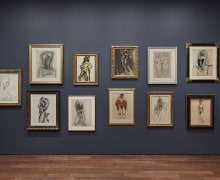
![Pablo Picasso, Femme nue debout [Standing Female Nude], 1906/1907. Ink and gouache on white laid paper 24 1/4 x 16 3/4 inches. The Metropolitan Museum of Art, New York.](https://img.artlogic.net/w_500,h_500,c_limit/exhibit-e/559650f9cfaf34ff158b4568/374d5eab0bfe770651a77a68a92f60d7.jpeg)
By David Rhodes
This exhibition, culled from seven decades of work, is curated by Olivier Berggruen and comprises over 80 drawings in a range of mediums that include colored pencil, crayon, graphite, charcoal, ink, pastel, collage, and watercolor. All of Pablo Picasso’s stylistic modes are represented in the trajectory of this exceptional installation. Invention and innovation leap from every change in direction, one technique superseding another and with elliptical explorations that return over the years: he never seems completely done with anything—there is still more to do with fresh insight and new discoveries. As with Picasso’s painting, printmaking, ceramics, and sculpture, his drawings push the medium fully, whether in homage to classical sources or in the total surprise of Cubist composition. The exhibition is on two floors and in four rooms and fully rewards spending as long as possible with it or making several visits.
Buste de femme (Bust of a Woman) (1907) and Femme nue debout (Standing Female Nude) (1906/1907) are two of a number of drawings here that clearly evince the decisive and lasting impact of African art on Picasso’s work. Both Polynesian and Dahomean (Beninois) images were more important even than the Egyptian images he admired; André Salmon observed the same year that these drawing were made, “Picasso in completely changing his work, would inevitably offer us an aspect of the world not in keeping with what we had learned to see.” In other words, without African and Oceanic art, it is impossible to see this turn in Western painting represented by Picasso’s painting, sculpture, and drawing from around 1907. Buste de femme is mask-like, simple, and direct in its construction. The charcoal line exposes the artist’s adjustments and revisions—adding subtlety, movement, fine modulations, and open workings in the progress of the drawing. Picasso has already demolished the categorical boundaries between classical and expressionist forms thanks to art he responded to in ethnographic museums and tried to mimic without understanding the works’ specific meanings or cultural contexts.
Picasso’s aesthetic precocity and sheer, overwhelming range in pursuing his work wherever it would lead him often astonishes. That it even came to his mind to do this is what surprises. For example, Portrait de femme endormie, III (Portrait of a Sleeping Woman, III) (1946), a horizontal, colored-crayon-on-paper portrait of a sleeping woman recalls in the colors—blue, pink, and red—together with its grouping of curvilinear shapes, the late paintings of Willem de Kooning. When color is part of a drawing’s composition Picasso is just as transformative as he is with graphite or charcoal, although the tone is almost always more astringent and tonally active in the latter. The simple forms to the left, bounded with bold line, are like those in a landscape—an abstracted hillside, boulders, woodland, fields—as are, despite the more legible rendering of head, face, and hair, those to the right; de Kooning, like Picasso, would never think of his paintings as completely abstract. All shapes and lines are active, as in a dream, but also at repose in an active stillness—the peaceful exhale after the unimaginable brutality of the war years and the occupation of France perhaps, or a simple act of desire and doting, or both.
Tête (Head) (1972), a drawing in pencil on paper, and borrowed for this exhibition from a private collection here in New York, was made less than nine months before the artist’s death. Of another self-portrait made the same year titled Self-portrait Facing Death (1972), Picasso said to his friend and biographer Pierre Daix, “I think I have touched on something. It is not like anything I have ever done.” In this frontal, fragmented, and psychologically tense portrait, it is the end-of-life’s sobering return to a child’s uncertainty in the face of extinction and the unknown that is so affecting. The Tête drawing here is still more unnerving—the vanitas portrait is of a helpless head of stone, a mute material that apprehensively anticipates death and the exit of human sentience. Again Picasso startles us: as Apollinaire had proposed in 1913, “And besides, anatomy, for example really no longer existed in art; it had to be reinvented, and everyone had to perform his own assassination with the methodical skill of a great surgeon.” Art had imitated life, until now.